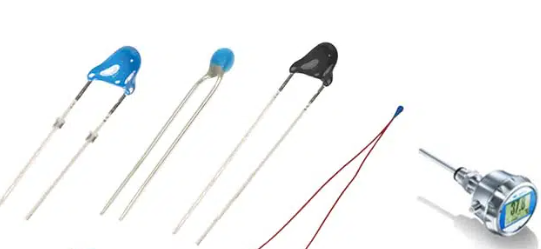Temperature Sensor : Types, Applications, Working Principle and Much More
A temperature sensor is a vital component in many systems where monitoring or controlling of temperature is required.

It allows one to measure the temperature of an object or environment and provide thermal data which is further used by various devices and applications.
Temperature sensors play an important role across many industries from automotive and medical to consumer appliances.
What is a temperature sensor?A temperature sensor is a device that helps in measuring the temperature of its environment, object or substance and converts the measurement into an electronic signal.
This electronic signal is further processed by auxiliary instrumentation such as temperature indicators, temperature controllers and temperature recorders to display or use the temperature data.
There are various types of temperature sensors available based on different sensing technologies like thermistor, thermocouple, Resistance Temperature Detector (RTD) etc.
What are different types of temperature sensors?Some of the common types of temperature sensors are:
Thermocouple
A thermocouple is a temperature sensor made by joining two different conductors at their ends to form a thermocouple junction. The voltage produced is dependent on the temperature difference between the thermocouple junction and a reference junction. Thermocouples are inexpensive, rugged and can measure a wide range of temperatures.
Resistance Temperature Detector (RTD)
An RTD is made up of a pure metal like platinum, copper or nickel which exhibits change in electrical resistance when exposed to change in temperature. The resistance increases linearly as temperature rises which makes it easy to convert to temperature using a simple formula. RTDs provide good accuracy over a wide temperature range.
Thermistor
A thermistor is a type of resistor whose resistance varies significantly with temperature changes. It exhibits a non-linear but known resistance-to-temperature relationship. Negative temperature coefficient (NTC) thermistors decrease in resistance with rising temperature while positive temperature coefficient (PTC) thermistors increase in resistance. They provide high accuracy and fast response time.
Integrated Circuit Sensor
An integrated circuit temperature sensor consists of a temperature sensitive circuit integrated onto a silicon chip that outputs voltage proportional to sensed temperature. They are small in size, inexpensive and mass producible. But accuracy is less as compared to other sensor types.
Infrared Sensor
Infrared sensors detect infrared energy radiated from an object or surface and produce an electronic signal proportional to the temperature. They are contactless and suitable to measure temperature without disturbing the environment but have less accuracy.
What are the advantages and disadvantages of temperature sensors?Advantages
• Provide accurate and repeatable temperature measurements.
• Respond quickly to temperature variations.
• Can measure a wide range of temperatures from below zero to thousands of degrees Celsius depending on type.
• Rugged, withstand vibrations and withstand hostile environmental conditions like humidity and pressure.
• Low cost options available for general purpose temperature measurements.
• Integrated circuit temperature sensors are small, mass producible and inexpensive.
Disadvantages
• Contact sensors disturb the medium whose temperature is being measured.
• Thermocouples produce small voltage signals requiring amplification.
• Response time of temperature sensors depends on thermal mass and insulation which limits fast temperature tracking.
• Temperature sensors have limited lifespan and require calibration over time.
• Special sensors are needed for measuring ultra-low or ultra-high temperatures.
How important is a temperature sensor?
A temperature sensor plays a vital role in maintaining quality and safety standards across many industries.
Some key applications where temperature sensors are mission critical include:
• Medical equipment and patient monitoring – Ensures safe temperatures for drug infusion, surgical/therapy devices, incubators etc.
• Automotive – Monitors engine temperature, fuel systems, brake fluid, transmission oil, exhaust gas recirculation.
• Industrial manufacturing – Controls processes in plastics molding, food processing, chemical reactions requiring specific temperatures.
• HVAC equipment – Essential component in thermostats, air conditioners, refrigerators to regulate temperatures.
• Fire/overheat detection – Prevents accidents by triggering alarms when abnormal high temperatures detected.
• Consumer appliances – Maintains safe cooking temperatures in ovens/stoves, cool temperatures in refrigerators.
Where are temperature sensors used?Industrial applications
Oil and gas plants to monitor pipeline temperatures, boiler temperatures.
Pulp and paper industry for dryer skin temperatures, consistency measurements.
Power plants to monitor transformer temperatures, boiler steam temperatures.
Iron and steel industry for molten metal temperatures, annealing furnace controls.
Automotive
Engine coolant temperature sensor in radiator.
Intake air temperature sensor.
Exhaust gas temperature sensor before catalytic converter.
Transmission fluid temperature sensor.
Rear differential and transfer case temperature sensors.
Medical
Patient thermoregulation- temperature probes in incubators, warming blankets.
Medical sterilizers- monitors autoclave temperatures.
Hyperthermia therapy- controls localized temperature increases.
HVAC
Thermostat temperature sensor
Duct-mounted temperature sensors
Outdoor temperature sensors
Household appliances
Refrigerator/freezer temperature sensors
Oven temperature sensors
Water heater thermostats
What is the difference between thermal sensor and temperature sensor?The main difference between a thermal sensor and a temperature sensor are:
Thermal sensors detect heat without direct contact while temperature sensors measure temperature through properties like resistance that change with temperature.
Thermal sensors provide relative heat indication without units while temperature sensors provide measured temperature output in units like Celsius or Fahrenheit.
How do temperature sensors work?Temperature sensors function based on different working principles depending on the sensing technology used:
Thermistors
Thermistors are made from semiconductor materials that change resistance predictably with temperature changes. As temperature rises, the mobility of charge carriers in the semiconductor increases resulting in lower electrical resistance that can be measured.
Thermocouples
When two different conductors are joined together, a voltage is produced dependent on their Seebeck coefficient and the temperature difference between the junction and reference junction. The output voltage is linearly proportional to temperature and is measured.
RTDs
Resistance Temperature Detectors use metals like platinum that change resistance reliably with temperature. Resistance increases linearly as temperature rises following PRT (Platinum Resistance Thermometers) or ITS-90 standard curves.
Integrated circuits
Complementary metal–oxide–semiconductors (CMOS) and bipolar transistors on an IC change current or voltage levels proportionally to temperature which is output analog or digital signals.
Infrared sensors
Infrared sensors contain a detector which absorbs infrared radiation from the target. The absorbed IR energy causes the detector temperature to rise above ambient. This temperature change alters the electrical properties to provide an output signal related to target temperature.
How to design a temperature sensor?
The steps involved in designing a temperature sensor are:
1. Select sensing element material based on required temperature range, accuracy, response time etc. like RTD, thermistor etc.
2. Design sensor probe matching application requirements like immersion, surface, air temperature sensing.
3. Choose appropriate housing material that withstands application environment. Consider thermal insulation, heat transfer etc.
4. Design signal conditioning circuitry to convert sensor output to standardized signals compatible with instruments like amplifiers, filters, transmitters etc.
5. Develop calibration curves and apply compensation algorithms in microcontroller if required for high accuracy.
6. Implement temperature scaling and linearization if needed in firmware or hardware.
7. Add optional features like remote sensor with transmission line, displays, alarms, microprocessor integration.
8. Test prototype under standard reference temperatures for calibration, accuracy, repeatability.
9. Enhance product through validation testing under field conditions, certifications.
10. Prepare design documentation for manufacturing.
What is the range of a temperature sensor?Temperature sensors can measure a wide range of temperatures based on the sensing technology and construction. Some common measurement ranges are:
• Thermocouples: -250°C to 1350°C
• RTDs: -200°C to 650°C
• Thermistors: -55°C to 150°C
• Integrated circuits: -55°C to 150°C
• Infrared sensors: -50°C to 500°C
Special types of sensors further extend the limits to measure very low cryogenic temperatures below -200°C for applications like liquified natural gas plants, high energy physics labs.
Similarly, special metallurgical thermocouples and optical pyrometer sensors go up to 3000°C for processes like steel making, glass welding.
ConclusionAn accurate and reliable temperature sensor is fundamental for process and quality control across major industries due to its role in monitoring, regulating and safety applications.
Understanding sensor types, principles, design and selection based on application demands is key.
Advancing technologies are continuously improving sensing capabilities to wider ranges, higher precisions and intelligent outputs.
As temperature measurement takes a more vital role, evolution of sensors will keep pace with the emerging trends.
在线留言询价
- 一周热料
- 紧缺物料秒杀
| 型号 | 品牌 | 询价 |
|---|---|---|
| BD71847AMWV-E2 | ROHM Semiconductor | |
| MC33074DR2G | onsemi | |
| TL431ACLPR | Texas Instruments | |
| RB751G-40T2R | ROHM Semiconductor | |
| CDZVT2R20B | ROHM Semiconductor |
| 型号 | 品牌 | 抢购 |
|---|---|---|
| STM32F429IGT6 | STMicroelectronics | |
| IPZ40N04S5L4R8ATMA1 | Infineon Technologies | |
| BU33JA2MNVX-CTL | ROHM Semiconductor | |
| TPS63050YFFR | Texas Instruments | |
| ESR03EZPJ151 | ROHM Semiconductor | |
| BP3621 | ROHM Semiconductor |
- 周排行榜
- 月排行榜
AMEYA360公众号二维码
识别二维码,即可关注


请输入下方图片中的验证码:






















